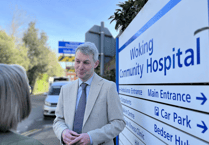I am delighted that the government has reached its target of 50,000 additional nurses in the NHS, marking the largest ever sustained growth in the NHS nursing workforce.
Data published by NHS England shows there were 51,245 additional nurses in September 2023 compared with 2019. This means the number of nurses has increased from 300,904 in 2019 to over 352,000 now – hitting the government’s manifesto commitment to recruit an additional 50,000 nurses earlier than first promised.
There are now also 7,300 (5.6 per cent) more doctors in the NHS compared to September 2022.
The additional 50,000 nurses commitment has been achieved through boosting training and education routes into nursing, ethically recruiting internationally and actions to improve the retention of the existing workforce. This includes a financial support package for nursing students – the NHS Learning Support Fund – providing eligible nursing, midwifery and allied health professions students with non-repayable grants of at least £5,000 per academic year to ensure course sustainability.
This expanded workforce should be capable of delivering hundreds of thousands of extra appointments, helping to tackle waiting lists and improve access for patients.
We have delivered on that promise, but we won’t be stopping there. The first ever NHS Long Term Workforce Plan will help to retain our workforce, reform clinical practice, and deliver the biggest training expansion in NHS history.
The NHS Long Term Workforce Plan – backed by more than £2.4billion over five years – sets out three priority areas, to train, retain and reform the health workforce.
The plan will significantly expand domestic education, training and recruitment and deliver more nurses than ever. It will almost double the number of adult nurse training places by 2031, with around 24,000 more nurse and midwife training places a year by 2031. This will include more than 5,000 more mental and learning-disability nurses a year.
These recruitment and retention measures will mean the health service has at least an extra 170,000 nurses by 2036 to 2037.
And as we start this new year, I am particularly looking forward to having a new diagnostic centre at Woking Community Hospital. This new state-of-the-art diagnostic hub will save Woking residents more than 30,000 trips a year to Ashford and St Peter’s Hospitals for a range of tests and scans.
This new hub has been made possible through direct extra investment into the NHS by the government. I was then delighted to secure double the amount of funding for this important project than was originally envisaged through my direct lobbying of the Health Secretary.
I will, of course, keep readers of this column updated on the progress of this new building at our community hospital.
Supporting our NHS, locally and nationally, has always been close to my heart and will continue to be a priority for me in 2024.




